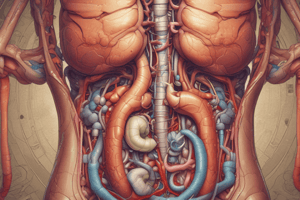Podcast
Questions and Answers
What role does amylase play in digestion?
What role does amylase play in digestion?
- It physically breaks down food into smaller pieces.
- It catalyzes the breakdown of proteins into amino acids.
- It breaks down polysaccharides into smaller sugars. (correct)
- It helps in absorbing nutrients in the stomach.
What is the purpose of the epiglottis during swallowing?
What is the purpose of the epiglottis during swallowing?
- To aid in the physical breakdown of food.
- To help produce saliva for digestion.
- To direct food into the esophagus and prevent it from entering the windpipe. (correct)
- To allow air to pass freely into the trachea.
Which of the following correctly describes the process of chewing?
Which of the following correctly describes the process of chewing?
- It prevents food from entering the mouth.
- It increases the size of food particles for easier swallowing.
- It physically breaks down food, increasing surface area for enzymes. (correct)
- It is solely a chemical process aided by enzymes.
What is the function of the esophagus?
What is the function of the esophagus?
What initiates the digestive process in the mouth?
What initiates the digestive process in the mouth?
What is the primary role of the digestive system?
What is the primary role of the digestive system?
What component of gastric juice helps kill bacteria found in food?
What component of gastric juice helps kill bacteria found in food?
Why does pepsinogen not damage the proteins inside the cell that produces it?
Why does pepsinogen not damage the proteins inside the cell that produces it?
What is the primary function of the kidneys?
What is the primary function of the kidneys?
How does the stomach prevent pepsin and hydrochloric acid from digesting its own epithelial cells?
How does the stomach prevent pepsin and hydrochloric acid from digesting its own epithelial cells?
Which substance does the liver convert to a less toxic form called urea?
Which substance does the liver convert to a less toxic form called urea?
What happens in the stomach when food enters it?
What happens in the stomach when food enters it?
What role do glomeruli play in the kidneys?
What role do glomeruli play in the kidneys?
What triggers the sensation of needing to urinate?
What triggers the sensation of needing to urinate?
How does the body primarily eliminate carbon dioxide?
How does the body primarily eliminate carbon dioxide?
Flashcards are hidden until you start studying
Study Notes
Upper Gastrointestinal Tract
- The digestive process begins in the mouth with salivary amylase breaking down food.
- Salivary glands release enzymes that convert large polysaccharides into smaller ones.
- Chewing increases the surface area of food for enzyme action.
The Throat
- The tongue shapes food into a bolus and directs it to the pharynx.
- Food enters the esophagus after swallowing, with the epiglottis preventing airway blockage.
- Muscle contractions in the esophagus push food into the stomach.
The Stomach
- The stomach can hold over half a gallon of food and fluid, stretching as necessary.
- Gastric juice, secreted by epithelial cells, facilitates food liquefaction and chemical breakdown.
- Hydrochloric acid (HCl) in gastric juice kills bacteria and assists in food digestion.
- Amylase is inactivated by HCl, maintaining only partial digestion of polysaccharides during this stage.
- Pepsinogen is the inactive precursor of pepsin, activated by HCl to prevent self-digestion of cells.
- Mucus secreted by epithelial cells protects them from damage by acid and enzymes.
- The stomach begins churning and secreting gastric juices in response to signals from the brain.
Pepsin Function
- Once food is present, gastric juice secretion increases, and the stomach thoroughly mixes food with digestive enzymes.
- The pyloric sphincter controls the release of chyme into the small intestine, taking 2 to 6 hours to empty.
Nutrient Absorption
- The small intestine, particularly the duodenum, continues digestion and nutrient absorption.
- The pancreas and the small intestine produce enzymes that aid in digesting carbohydrates, proteins, and fats.
- Bicarbonate neutralizes stomach acid entering the small intestine.
Lower Gastrointestinal Tract
- The jejunum absorbs sugars, amino acids, and fatty acids, aided by villi and microvilli.
- The ileum absorbs bile salts and Vitamin B12 and secretes digestive enzymes.
- The large intestine absorbs water and electrolytes, converting waste into stool.
Excretory System
- Kidneys filter waste products from blood, while dialysis treats kidney failure by removing waste and balancing fluids.
- The liver detoxifies harmful substances, such as converting ammonia into less toxic urea.
Urine Filtration Process
- Nephrons in the kidneys filter blood, reabsorbing water and nutrients while concentrating waste into urine.
- Urea exits the kidneys through ureters to the bladder, which signals when it is full.
Bladder Function
- The bladder stretches as it fills, sending signals to the brain, indicating the need to urinate.
- Control over urination is maintained via a muscular valve at the bladder's exit, leading to the urethra.
Nervous System Overview
- Comprises neurons transmitting signals, processing sensory information, and controlling actions.
- Divided into the central nervous system (CNS) and peripheral nervous system (PNS).
- The autonomic nervous system regulates unconscious processes, while the somatic nervous system governs voluntary actions.
Studying That Suits You
Use AI to generate personalized quizzes and flashcards to suit your learning preferences.


